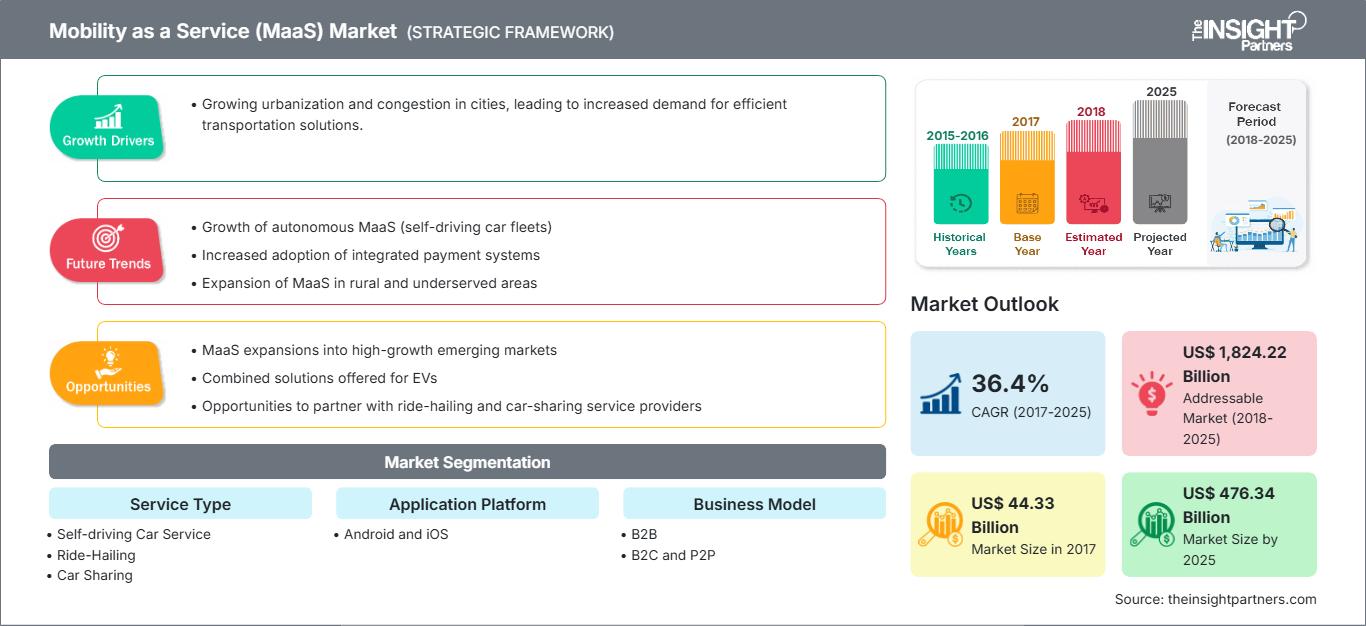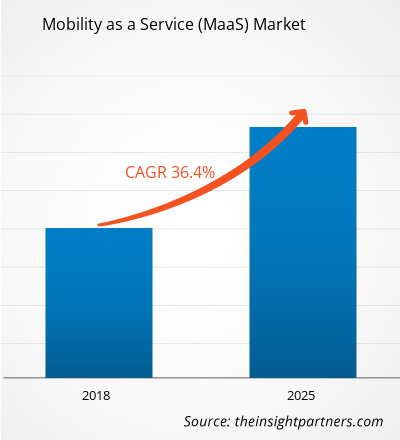[연구 보고서] 서비스형 모빌리티(MaaS) 시장은 2017년 443억 3천만 달러 규모였으며, 2025년에는 4,763억 4천만 달러에 이를 것으로 전망됩니다. 2018년부터 2025년까지 연평균 성장률(CAGR)은 36.4%에 달할 것으로 예상됩니다.
분석가 관점:
서비스형 모빌리티(MaaS) 시장은 최근 몇 년간 급속한 성장과 변화를 겪고 있습니다. MaaS는 대중교통, 승차 공유, 자전거 공유, 카 공유 등 다양한 교통 수단이 단일 플랫폼 또는 서비스로 통합되어 사용자에게 원활하고 편리한 교통 경험을 제공하는 개념을 의미합니다. 지속 가능하고 효율적인 교통 솔루션에 대한 수요 증가, 기술 발전, 그리고 공유 경제의 부상으로 MaaS 시장은 상당한 주목을 받고 있습니다. MaaS 플랫폼은 일반적으로 실시간 여행 정보, 예약 및 결제 서비스, 개인 맞춤형 경로 계획 등 다양한 옵션을 제공하며, 이러한 모든 서비스는 모바일 애플리케이션이나 온라인 플랫폼을 통해 이용할 수 있습니다. MaaS 시장의 주요 동인 중 하나는 전 세계 도시의 도시화와 교통 체증 심화입니다. 더 많은 사람들이 도시로 이동함에 따라 효율적인 교통 수단의 중요성이 커지고 있습니다. MaaS는 사용자의 특정 요구에 맞춘 포괄적인 교통 옵션을 제공함으로써 이러한 과제를 해결하는 것을 목표로 합니다. 이를 통해 자가용 의존도를 줄이고, 교통 체증을 완화하며, 전반적인 교통 효율성을 향상시킬 수 있습니다. 모바일 연결, GPS, 데이터 분석과 같은 디지털 기술의 발전으로 MaaS 플랫폼 내에서 다양한 교통 수단을 원활하게 통합할 수 있게 되었습니다. 이러한 통합을 통해 사용자는 단일 애플리케이션을 사용하여 전체 여정을 계획, 예약 및 결제할 수 있으므로 여러 티켓이나 별도의 결제 시스템이 필요하지 않습니다. 사용자의 이동 패턴과 선호도에서 수집된 데이터는 교통망 최적화, 서비스 품질 향상, 전반적인 사용자 경험 향상에 활용될 수 있습니다. MaaS 시장은 또한 운송 사업자, 기술 제공업체, 정부를 포함한 이해관계자 간의 협력이 증가하고 있습니다. 대중교통과 민간 모빌리티 서비스를 통합하는 MaaS 생태계를 개발하기 위한 민관 파트너십이 형성되고 있습니다. 각국 정부는 MaaS가 교통 문제 해결에 기여할 수 있는 잠재력을 인지하고 있으며, 정책 프레임워크와 자금 지원 사업을 통해 MaaS 도입을 적극적으로 지원하고 있습니다.
시장 개요:
고객 중심의 교통 개념을 "서비스로서의 모빌리티(Mobility as a Service)"라고 합니다. 이 서비스를 통해 고객은 다양한 모빌리티 서비스를 계획, 예약 및 결제할 수 있습니다. 택시, 렌터카, 자전거 및 차량 공유 등의 교통 옵션을 디지털 채널을 통해 통합합니다. MaaS 개발의 주요 목표는 여행객의 여행 니즈에 맞는 맞춤형 모빌리티 솔루션을 제공하는 것입니다.
요구 사항에 맞게 이 보고서를 사용자 정의하십시오.
이 보고서의 일부, 국가 수준 분석, Excel 데이터 팩을 포함하여 모든 보고서에 대한 사용자 정의를 무료로 받을 수 있을 뿐만 아니라 스타트업 및 대학을 위한 훌륭한 제안 및 할인을 이용할 수 있습니다
서비스로서의 모빌리티(MaaS) 시장: 전략적 통찰력

-
이 보고서의 주요 주요 시장 동향을 확인하세요.이 무료 샘플에는 시장 동향부터 추정 및 예측에 이르기까지 데이터 분석이 포함됩니다.
시장 성장 동력:
도시화 및 스마트 시티 이니셔티브 확대, MaaS(Mobility as a Service) 시장 성장 견인
도시화 및 스마트 시티 이니셔티브 확대는 MaaS(Mobility as a Service) 시장 발전을 촉진하는 데 중요한 역할을 합니다. 전 세계 도시들이 인구 밀도 증가, 교통 체증, 환경 문제로 어려움을 겪고 있는 가운데, MaaS는 이러한 문제를 해결할 수 있는 유망한 해결책으로 떠오르고 있습니다. 도시화는 도시 인구 집중을 심화시켜 효율적이고 지속 가능한 교통 수단에 대한 수요를 증가시킵니다. MaaS는 대중교통, 승차 공유, 자전거 공유, 자율주행차 등 다양한 교통 수단을 단일 플랫폼으로 통합하여 모빌리티에 대한 총체적인 접근 방식을 제공합니다. 이러한 통합적인 접근 방식을 통해 도시 거주자는 개인 차량에만 의존하지 않고 편리하게 이동 경로를 계획, 예약, 결제할 수 있습니다. MaaS를 통해 다양한 교통 옵션을 제공함으로써 도시는 교통 체증을 줄이고 주차 문제를 완화하며 전반적인 교통 효율성을 향상시킬 수 있습니다. 스마트 시티 이니셔티브는 기술과 데이터를 활용하여 도시 모빌리티를 최적화함으로써 MaaS의 성장을 더욱 촉진합니다. 스마트 시티는 지능형 교통 시스템, 센서, 연결성을 구축하여 교통 패턴, 주차 공간, 대중교통 이용률에 대한 실시간 데이터를 수집합니다. 이 데이터는 MaaS 플랫폼을 통해 예측 알고리즘을 개발하고 사용자에게 맞춤형 추천을 제공하는 데 사용됩니다. MaaS는 기술과 데이터 기반 인사이트를 활용하여 도시가 원활하고 효율적인 교통 서비스를 제공할 수 있도록 지원하여 궁극적으로 주민의 삶의 질을 향상시킵니다.
더불어, 스마트 시티 이니셔티브는 지속가능성과 환경적 고려 사항을 우선시하는 경우가 많습니다. MaaS는 공유 모빌리티를 촉진하고, 자가용 의존도를 줄이며, 전기차를 교통 생태계에 통합함으로써 이러한 목표에 완벽하게 부합합니다. MaaS를 통해 도시는 대중교통, 승차 공유, 기타 친환경 교통 수단을 장려하여 탄소 배출량을 줄이고 대기질을 개선할 수 있습니다. 지속가능성 목표와의 이러한 연계성은 더욱 푸르고 살기 좋은 도시 환경을 조성하고자 하는 스마트 시티에 MaaS를 매력적인 솔루션으로 만듭니다. 또한 디지털 결제 시스템, 커넥티드 모빌리티 플랫폼, 스마트 교통 허브와 같은 스마트 시티 인프라는 MaaS 구축을 위한 탄탄한 기반을 제공합니다. 이러한 기술 발전은 다양한 교통 수단의 원활한 통합을 촉진하여 사용자가 서비스에 손쉽게 접근하고 결제할 수 있도록 합니다. MaaS 플랫폼이 제공하는 편의성과 사용 편의성은 더 많은 사람들이 지속 가능하고 다양한 교통 수단을 선택하도록 유도하여 시장 성장을 더욱 촉진합니다.
세분화 분석:
애플리케이션 플랫폼을 기준으로 시장은 안드로이드, iOS, 기타로 분류됩니다. 안드로이드 부문은 2020년 MaaS(Mobility as a Service) 시장에서 가장 큰 점유율을 차지했으며, 예측 기간 동안 시장에서 가장 높은 연평균 성장률(CAGR)을 기록할 것으로 예상됩니다. 안드로이드 부문은 MaaS(Mobility as a Service) 시장에서 가장 큰 점유율을 차지하며 선두 주자로 부상했습니다. 이는 광범위한 도입, 오픈 소스 특성, 다양한 하드웨어 및 연결 옵션과의 호환성, 강력한 앱 생태계, 그리고 다른 Google 서비스와의 통합 덕분입니다. 안드로이드는 광범위한 사용자 기반, 광범위한 개발자 커뮤니티, 그리고 다양한 MaaS 애플리케이션 및 솔루션을 제공함으로써 시장 지배력을 확보했습니다. 또한, 구글 지도와의 통합과 다양한 교통 수단을 지원하는 능력은 MaaS 제공업체들이 선호하는 플랫폼으로서 안드로이드의 입지를 더욱 공고히 했습니다.
지역 분석:
아시아 태평양 지역 MaaS(Mobility as a Service) 시장은 2017년 미화 162억 3천만 달러 규모였으며, 2025년까지 미화 1,982억 9천만 달러에 이를 것으로 예상됩니다. 예측 기간 동안 연평균 성장률(CAGR)은 38.9%에 달할 것으로 예상됩니다. 아시아 태평양 지역은 MaaS(Mobility as a Service) 시장의 선두 주자로 부상했으며, 몇 가지 주요 요인으로 인해 두드러진 입지를 확보했습니다. 이 지역의 급속한 도시화와 인구 증가는 효율적이고 지속 가능한 교통 솔루션에 대한 강력한 수요를 창출했습니다. 중국, 인도, 일본, 한국과 같은 국가의 인구 밀도가 높은 도시들은 심각한 교통 체증과 오염 문제에 직면해 있습니다. MaaS는 통합적이고 복합적인 교통 옵션을 제공하여 사용자가 도시 환경을 쉽게 탐색할 수 있도록 하는 유망한 솔루션을 제공합니다. 아시아 태평양 지역은 눈부신 디지털 인프라와 모바일 기술 발전을 경험했습니다. 스마트폰 보급률이 높고 모바일 인터넷 접근성이 확대됨에 따라 이 지역은 MaaS 플랫폼과 서비스를 지원할 준비가 잘 되어 있습니다. 한국과 일본과 같이 기술 도입이 빠른 것으로 알려진 국가의 기술 활용 인구는 이 지역의 MaaS 성장을 더욱 촉진하고 있습니다. 또한, 정부의 적극적인 정책과 사업은 아시아 태평양 지역의 MaaS 발전을 촉진하는 데 중요한 역할을 했습니다. 싱가포르와 중국과 같은 국가 정부는 스마트 시티 사업과 지속 가능한 교통 시스템을 적극적으로 추진하고 MaaS 도입을 장려하기 위한 인센티브와 규제 프레임워크를 제공했습니다. 이러한 노력은 MaaS 제공업체가 서비스를 운영하고 확장할 수 있는 환경을 조성했습니다. Grab, Gojek, Didi Chuxing은 자전거 공유, 카셰어링, 통합 교통 플랫폼 등 기존의 승차 공유 서비스를 넘어 다양한 모빌리티 서비스를 제공하며 강력한 입지를 구축했습니다. 이러한 기업들은 광범위한 네트워크와 사용자 기반을 구축하여 이 지역의 MaaS 도입을 촉진해 왔습니다. 또한, 아시아 태평양 지역의 문화적, 지리적 다양성은 MaaS 제공업체에게 특별한 기회를 제공합니다. 국가마다 교통 수요와 선호도가 다르기 때문에 맞춤형 지역 맞춤형 솔루션이 필요합니다. 각 시장의 특정 수요에 맞춰 서비스를 조정할 수 있는 MaaS 제공업체는 이 지역에서 경쟁 우위를 확보했습니다.
서비스형 모빌리티(MaaS) 시장 지역별 통찰력
The Insight Partners의 분석가들은 예측 기간 동안 MaaS(Mobility as a Service) 시장에 영향을 미치는 지역별 동향과 요인을 면밀히 분석했습니다. 이 섹션에서는 북미, 유럽, 아시아 태평양, 중동 및 아프리카, 그리고 중남미 지역의 MaaS(Mobility as a Service) 시장 세분화 및 지역별 분포도 살펴봅니다.
서비스형 모빌리티(MaaS) 시장 보고서 범위
| 보고서 속성 | 세부 |
|---|---|
| 시장 규모 2017 | US$ 44.33 Billion |
| 시장규모별 2025 | US$ 476.34 Billion |
| 글로벌 CAGR (2017 - 2025) | 36.4% |
| 이전 데이터 | 2015-2016 |
| 예측 기간 | 2018-2025 |
| 다루는 세그먼트 |
By 서비스 유형
|
| 포함된 지역 및 국가 |
북미
|
| 시장 선도 기업 및 주요 회사 프로필 |
|
서비스형 모빌리티(MaaS) 시장 참여자 밀도: 비즈니스 역학에 미치는 영향 이해
서비스형 모빌리티(MaaS) 시장은 소비자 선호도 변화, 기술 발전, 그리고 제품 이점에 대한 인식 제고 등의 요인으로 인한 최종 사용자 수요 증가에 힘입어 빠르게 성장하고 있습니다. 수요가 증가함에 따라 기업들은 제품 및 서비스를 확장하고, 소비자 니즈를 충족하기 위한 혁신을 추진하며, 새로운 트렌드를 적극 활용하고 있으며, 이는 시장 성장을 더욱 가속화하고 있습니다.

- 을 얻으세요 서비스로서의 모빌리티(MaaS) 시장 주요 주요 플레이어 개요
주요 업체 분석:
서비스형 모빌리티(MaaS) 시장 분석에는 Lyft, Inc., Uber Technologies, Inc., Moovel Group GmbH, Beeline Singapore, Whim App (MaaS Global Oy), Splyt Technologies Ltd., Qixxit, UbiGo AB, Tethys Technology, Inc., Smile Mobility, SkedGo Pty Ltd, Transit Systems Pty Ltd., Citymapper 등의 업체가 포함됩니다. 서비스형 모빌리티 업체 중 Moovel Group GmbH와 Smile Mobility는 다양한 제품 포트폴리오를 제공하여 상위 두 업체로 꼽힙니다.
최근 동향:
서비스형 모빌리티 시장에서는 인수합병과 같은 비무기적 전략과 유기적 전략이 활발하게 활용되고 있습니다. 최근 주요 시장 동향은 다음과 같습니다.
- 2022년 8월, 전기차 기업 Lime과 모빌리티 앱 Whim은 협력 관계를 다른 국가로 확대했습니다. 2022년 6월, Whim은 벨기에 앤트워프와 브뤼셀에 전기 스쿠터를 출시했고, 이어 핀란드 헬싱키에도 진출했습니다. Whim은 취리히, 빈터투어, 바젤에 있는 모든 Lime 전기 스쿠터를 이용할 수 있습니다. Whim은 10개 이상의 도시에 있는 두 곳의 다른 전기 스쿠터 공급업체와 더불어 사용자가 다양한 교통 수단을 이용하여 여행을 계획, 예약 및 결제할 수 있도록 지원합니다.
- 2022년 5월, FOD Mobility Group은 Mobilleo 고객을 위한 맞춤형 마케팅 지원 서비스를 출시했습니다. FOD Mobility Group은 이제 자체적으로 필요한 마케팅 경험이나 리소스를 갖추지 못한 고객을 위해 포괄적인 맞춤형 마케팅 지원 서비스를 제공하는 동시에, 시장을 선도하는 모바일 플랫폼을 통해 MaaS(Mobility as a Service) 기술을 직접 제공합니다.
- 과거 분석(2년), 기준 연도, CAGR을 포함한 예측(7년)
- PEST 및 SWOT 분석
- 시장 규모 가치/거래량 - 글로벌, 지역, 국가
- 산업 및 경쟁 환경
- Excel 데이터세트
최근 보고서
사용 후기
구매 이유
- 정보에 기반한 의사 결정
- 시장 역학 이해
- 경쟁 분석
- 고객 인사이트
- 시장 예측
- 위험 완화
- 전략 기획
- 투자 타당성 분석
- 신흥 시장 파악
- 마케팅 전략 강화
- 운영 효율성 향상
- 규제 동향에 발맞춰 대응






















 무료 샘플 받기 - 서비스로서의 모빌리티(MaaS) 시장
무료 샘플 받기 - 서비스로서의 모빌리티(MaaS) 시장